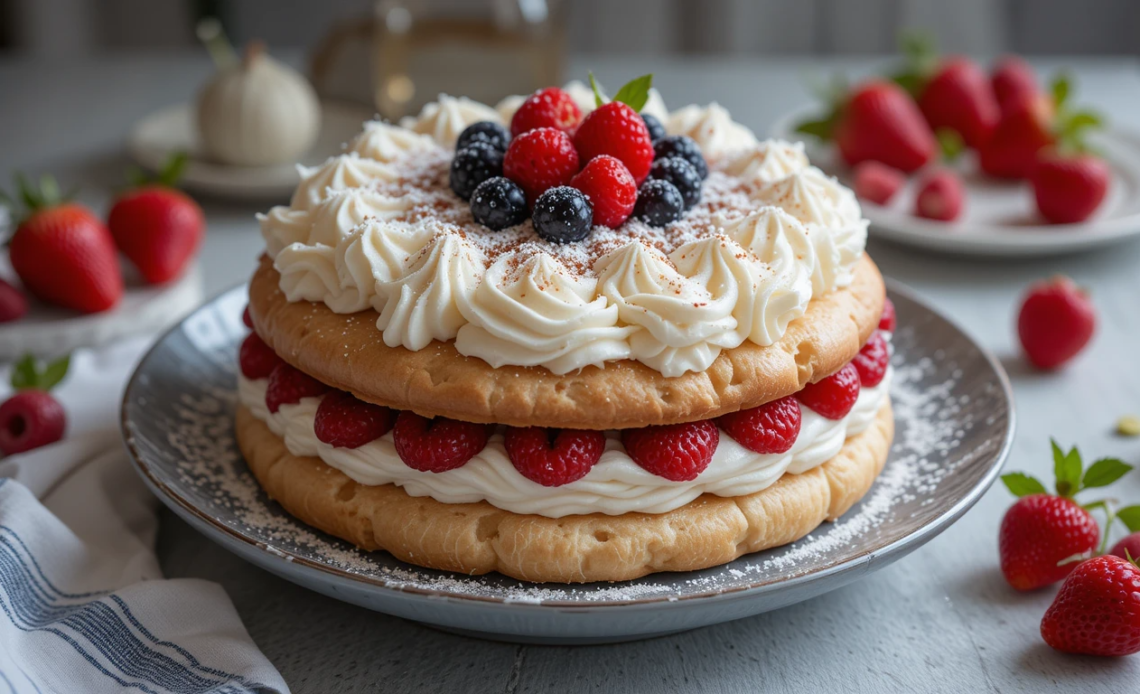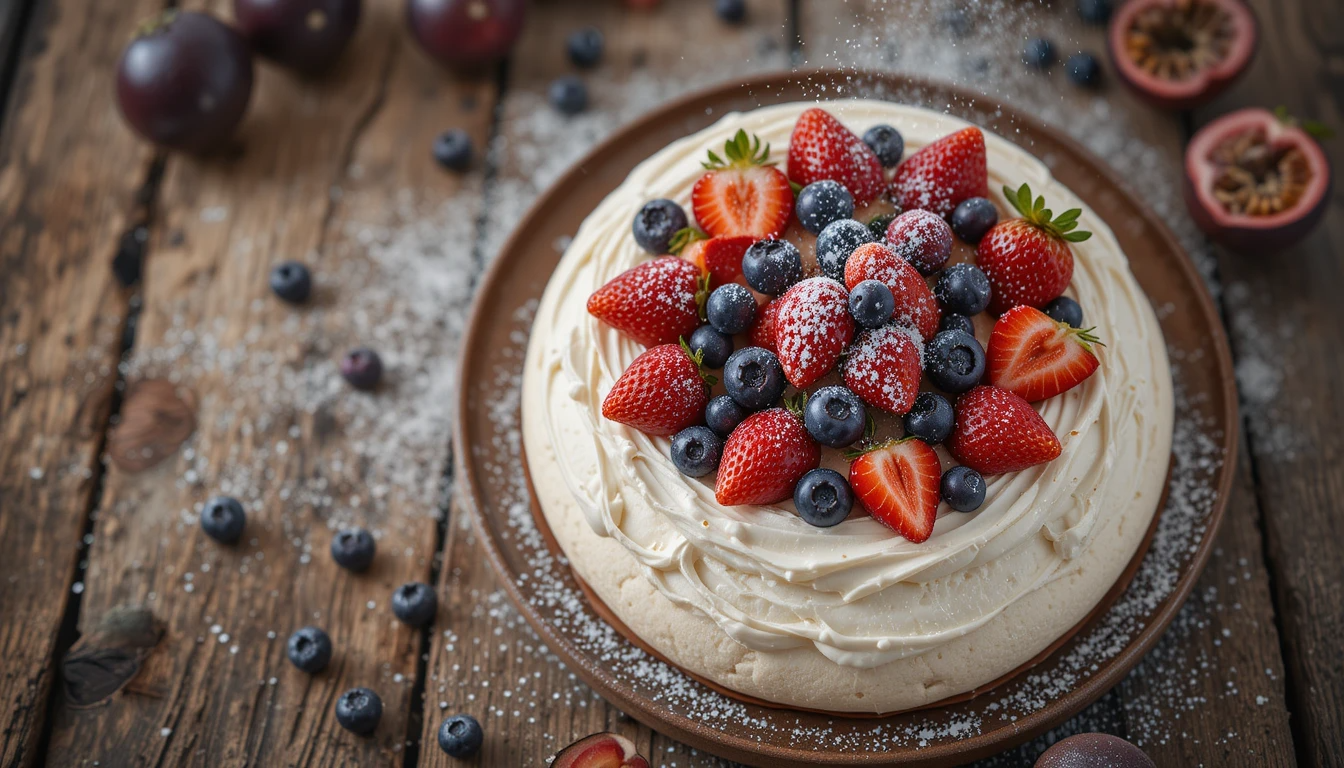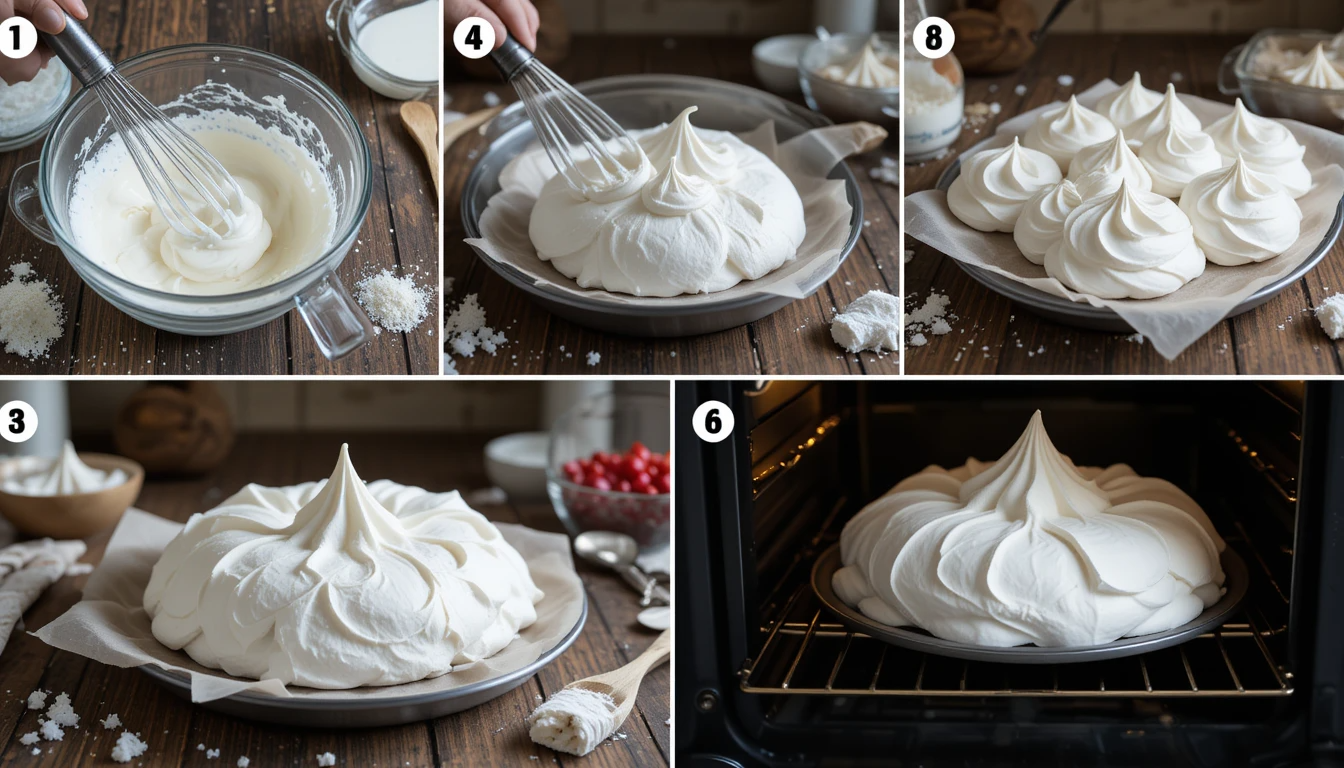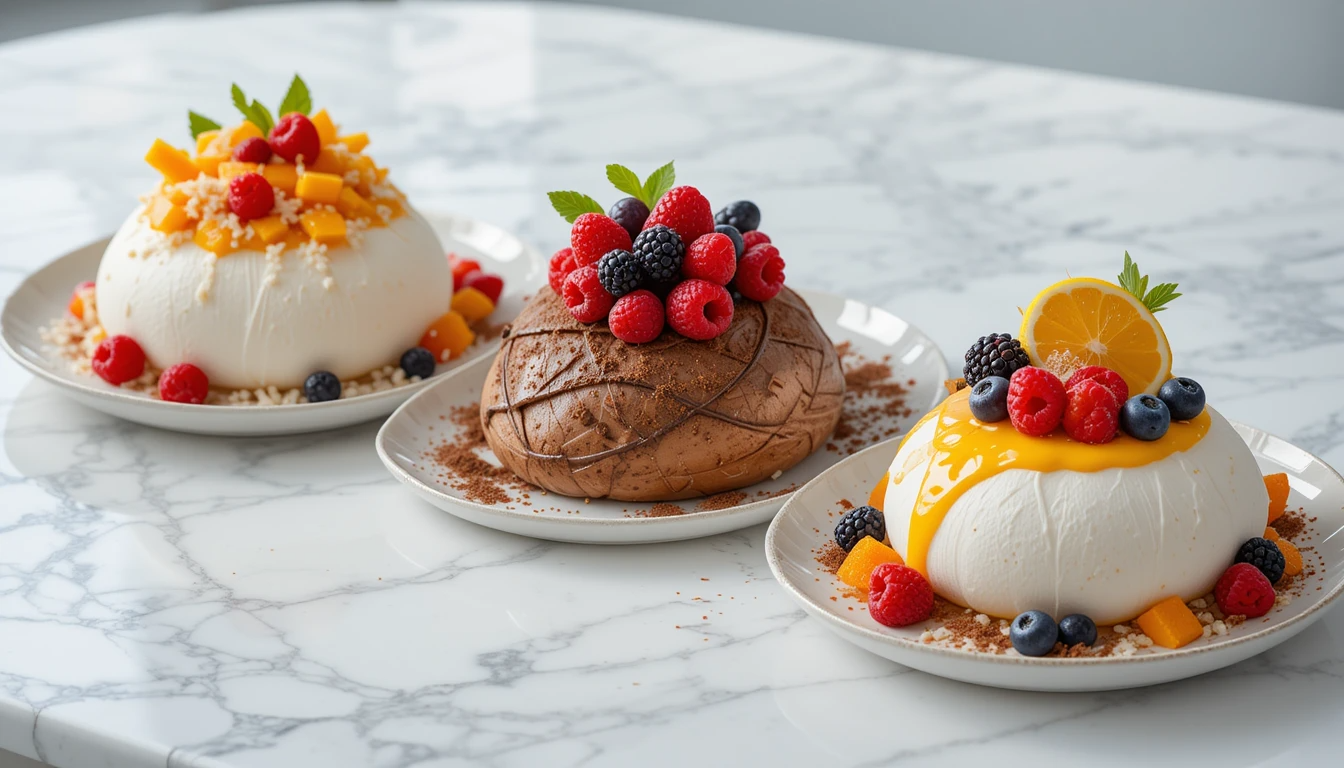
Pavlova is a meringue-based dessert cherished for its crisp crust and marshmallow-soft interior. I
ts hallmark combination of pillowy egg whites, sugar, and vibrant toppings creates a uniquely airy texture.
Prepared correctly, a Pavlova practically melts on your tongue with every bite.
Table of Contents
Introduction
Imagine a dessert so delicate that it feels like biting into a sweet, edible cloud. That heavenly treat you’re picturing is likely Pavlova. From its whimsical shape to its billowy center, Pavlova beckons dessert lovers with an almost magnetic appeal. But this dessert isn’t just about good looks—there’s a storied history, plenty of culinary science, and loads of playful variations behind it. Whether you’re a seasoned home baker or someone simply enamored with sweet treats, getting acquainted with Pavlova will undoubtedly add a new dimension to your dessert repertoire.
By the end of this article, you’ll uncover why Pavlova has danced its way into worldwide popularity, how to craft your own flawless version, and how to top it in a manner that dazzles the taste buds. You’ll also discover expert tips, plus a dash of playful creativity that makes each Pavlova experience feel like a personal masterpiece. So, buckle up your apron, warm up your whisk, and let’s float into the dreamy world of Pavlova together.
A Brief History of Pavlova

If you’ve ever gazed upon a perfectly airy Pavlova, you might have wondered how it came into existence. According to popular lore, Pavlova is named after the famous Russian ballerina Anna Pavlova. The dessert was purportedly created in her honor during a tour to Australia and New Zealand in the 1920s. Since then, both Aussies and Kiwis have jostled for official ownership, each proud to claim the invention of this spectacular confection.
Anna Pavlova’s Legacy
It’s often said that Anna Pavlova herself was as light on her feet as the dessert that bears her name. The dessert’s signature shape—a round, pillowy base with softly swooping edges—reminds many of a graceful tutu. Historians sometimes debate the exact location and date of its birth, but the popular narrative ties it firmly to the performing arts, celebratory gatherings, and a quest to honor something (or someone) truly remarkable. If there’s anything we can all agree on, it’s this: Pavlova’s legacy has expanded far beyond its storied beginnings, crossing continents and cultures in an unassumingly elegant swirl of meringue.
The Science Behind a Perfect Pavlova
A key reason Pavlova stands out among desserts is its airy texture—neither merely a meringue cookie nor a cake. Achieving the ideal fluff demands a bit of culinary science.
Egg Whites and Sugar: A Dazzling Duo
When you combine egg whites and sugar and then whip them, you’re essentially trapping air into a protein-sugar network. This trapped air is what gives Pavlova its hallmark volume. The outside sets to a crisp shell in the oven, while the inside remains soft and marshmallow-like.
- Tip: Use room-temperature egg whites, as they whip up with more volume.
- Tip: Gradually incorporate sugar into the egg whites so each grain dissolves seamlessly.
- Tip: Ensure your mixing bowl is squeaky clean—any hint of oil or grease can sabotage your fluff.
Stabilizers Make Magic
While classic Pavlova is built on egg whites and sugar, many bakers incorporate an acid (like vinegar or lemon juice) or a bit of cornstarch to stabilize the meringue. This helps the meringue retain its shape and reduces the chance it will collapse. Cornstarch promotes that marshmallowy interior, while vinegar lends a subtle tang that offsets the sweetness.
- Playful Experiment: Try different acids—like cream of tartar or apple cider vinegar—to see how they tweak the taste of your Pavlova.
- Disclaimer: This dessert is for personal enjoyment and creative experimentation. If you have specific dietary restrictions or concerns, consult with a qualified health professional.
Gathering Your Ingredients: The Core of Pavlova
To fashion a show-stopping Pavlova, you won’t need a laundry list of odd items. In fact, one of Pavlova’s many charms is its simplicity.
Below is a table outlining the essential ingredients and the added elements you can consider for topping or flavoring your Pavlova:
| Ingredient | Role in Pavlova | Notes |
|---|---|---|
| Egg Whites | Structural Base | Use fresh, room-temp eggs for best volume. |
| Sugar (Castor Sugar) | Sweetness & Stabilization | Helps the meringue form stiff, glossy peaks. |
| Acid (Vinegar/Lemon) | Stabilizer | Reinforces the foam’s structure. |
| Cornstarch (Optional) | Texture Enhancer | Adds that signature marshmallowy interior. |
| Whipped Cream | Classic Topping | Soft, unsweetened or lightly sweetened is ideal. |
| Fresh Fruit | Flavor & Color | Berries, kiwis, or tropical fruits add vibrancy. |
| Additional Toppings | Extra Flair | Drizzle chocolate, salted caramel, or fruit coulis. |
Why Quality Matters
While it’s true that Pavlova requires only a handful of ingredients, their quality makes all the difference. Fresh egg whites yield better volume and stability, and high-quality sugar ensures the dessert’s delicate structure. Even the toppings—whether fresh strawberries or tangy passion fruit—will shine far brighter if you pick them at their peak ripeness. Remember, Pavlova might be simple, but that simplicity puts each component front and center.
Step-by-Step Guide to Baking Pavlova

When you first tackle Pavlova, it can feel like an intricate dance. But the process is surprisingly straightforward if you follow a few key steps.
- Prep Your Equipment
- Start by cleaning and drying your mixing bowl and whisk thoroughly.
- Preheat your oven to around 300°F (150°C).
- Whip the Egg Whites
- Separate your egg whites, making sure no yolk slips in.
- Begin whisking at a lower speed until they become foamy, then slowly increase the speed.
- Incorporate the Sugar
- Add sugar in small increments, whisking well after each addition.
- Aim for stiff, glossy peaks. You’ll know it’s ready if you rub a bit of the mixture between your fingertips and don’t feel any sugar granules.
- Add Stabilizers
- Gently fold in cornstarch and an acid (e.g., vinegar). This step is crucial for that classic Pavlova consistency.
- Shape the Meringue
- Transfer the mixture onto a parchment-lined baking sheet, shaping a circular mound.
- Use a spatula to create gentle swoops and a slight indentation in the middle.
- Bake and Dry
- Lower the oven temperature to about 250°F (120°C) once you put the Pavlova in.
- Bake for around 60–90 minutes until the outside is crisp and pale.
- Turn off the oven and let the Pavlova cool inside with the door slightly ajar for another hour.
- Top and Serve
- Once cool, load the top with whipped cream and fresh fruit.
- Serve immediately to showcase its crisp edges and soft interior.
If you have a sweet tooth that demands perfection, don’t open the oven door until the baking time is up—abrupt changes in temperature can cause cracks or flattening. And if you do notice small cracks, don’t panic. A few cracks add charm, and the whipped cream topping can mask any imperfections.
Flavor Variations and Creative Twists

Although the classic Pavlova with whipped cream and fresh berries is a timeless favorite, you can easily tailor it to reflect seasonal fruits, personal taste preferences, or cultural flair.
Tropical Treat
- Base: Classic meringue base (egg whites, sugar, cornstarch, vinegar).
- Toppings: Mango slices, passion fruit pulp, toasted coconut flakes.
- Flavor: Tropical sweetness and a tangy punch that complement the sugary base.
Chocolate Lover’s Pavlova
- Base: Fold in a couple of tablespoons of cocoa powder with the cornstarch.
- Toppings: Whipped cream, chocolate shavings, fresh raspberries.
- Flavor: Rich cocoa merges with crisp meringue, delivering an almost brownie-like interior.
Citrus Zest
- Base: Grate in some lemon or orange zest for a subtle pop.
- Toppings: Lemon curd, whipped cream, fresh berries.
- Flavor: Bright and tangy, cutting through the dessert’s sweetness.
The possibilities are truly endless. Feel free to experiment with nuts, caramel swirls, rosewater, or even edible flowers. The key is balance: Pavlova is all about that airy, lightly sweet base highlighting vibrant or contrasting flavors on top.
Serving and Storing Pavlova
Once your Pavlova is done baking, it’s tempting to dive in immediately—and, indeed, that’s partly correct. You should top it with whipped cream and fruit close to serving time to preserve the crispness of the meringue shell. However, if you have leftovers (a rare occurrence!), you’ll want to store them carefully.
Serving Tips
- Timing: Ideally, assemble your Pavlova shortly before you plan to serve it, preventing sogginess.
- Slicing: Use a sharp, serrated knife, and cut in gentle sawing motions.
- Pairing: Serve with a light dessert wine, a cup of tea, or coffee to complement the sugary base.
Storing Tips
- Unadorned Base: If you know you’ll have leftovers, store the unadorned base in an airtight container at room temperature.
- Assembled Pavlova: Once topped with cream and fruit, keep it in the refrigerator, but be aware the meringue shell will gradually soften.
- Shelf Life: Generally, the crispness fades after a day, so it’s best enjoyed fresh.
Pavlova Around the World
Despite its roots in Australia and New Zealand, Pavlova has made its way around the globe. In the United States, you’ll see it pop up on summer picnic tables or at elegant dinner parties. In the United Kingdom, it’s a favored sweet during festive gatherings, especially in the warmer months when fresh berries overflow at farmers markets.
Cultural Variations
- Europe: Some European bakers add an extra layer of pastry cream beneath the whipped cream for a richer dessert.
- Asia: Matcha-flavored Pavlovas have gained popularity, blending the dessert’s sweetness with green tea’s earthiness.
- Latin America: Tropical fruits like guava, pineapple, and papaya often decorate the top, infusing the dessert with a burst of sunshine.
Pavlova’s global appeal might be due to its adaptability. Few desserts can so effortlessly incorporate local fruit, flavors, or festive garnishes. No matter where you travel, the airy crispness and marshmallowy heart remain the soul of Pavlova.
The Art of Presentation
When unveiling your Pavlova, presentation can feel almost as important as taste. The swirl of pillowy meringue, the cascade of cream, and the rainbow of vibrant fruit all set the stage for an unforgettable sweet course.
Styling Secrets
- Height for Drama: Build your Pavlova with a slightly elevated shape. A dramatic mound can instantly elevate its table presence.
- Fruit Placement: For a neat look, place bigger fruit pieces first, then fill gaps with smaller berries.
- Sauce Drizzles: A drizzle of berry coulis or chocolate sauce can turn your Pavlova into a real showstopper.
Remember, Pavlova is often the final dish served—akin to a grand finale in a performance. The anticipation builds throughout the meal, culminating in that first airy, sugary forkful. So, let your creativity shine, and don’t shy away from playful experiments in plating.
Frequently Asked Questions
1) What are the main ingredients in pavlova?
Pavlova typically calls for egg whites, sugar, and a stabilizing acid like vinegar. These components create its signature airy interior and crisp exterior. Adding whipped cream and fresh fruit completes the essential Pavlova experience.
2) What is the secret to the best pavlova?
The best Pavlova relies on gradually adding sugar to well-whipped egg whites for maximum volume and stability. A small amount of cornstarch and vinegar helps achieve that perfect marshmallow-like center. Baking it low and slow gives your Pavlova a crisp shell and tender core.
3) Why is pavlova famous?
Pavlova gained fame thanks to its light, billowy texture and its intriguing origin story involving a celebrated ballerina. Its worldwide popularity also stems from its adaptability to various toppings and flavors. The crisp exterior and cloud-like interior make Pavlova unforgettable.
4) Is pavlova Aussie or Kiwi?
Both Australia and New Zealand claim Pavlova as their culinary invention. Historically, it traces back to the 1920s and honors Russian ballerina Anna Pavlova. Either way, Pavlova has become a beloved dessert in both nations and far beyond.
Conclusion
Pavlova is much more than just a dessert—it’s a sweet symbol of culinary artistry. From its delicate, cloud-like texture to its infinite topping possibilities, Pavlova stands out as a universal favorite in the dessert pantheon. Whether you’re a fervent traditionalist, insisting on classic whipped cream and strawberries, or a fearless innovator layering tropical fruit and chocolate shavings, the end goal is always the same: a breathtaking, melt-in-your-mouth creation.
Throughout this article, you’ve gained insights into Pavlova’s enchanting history, discovered tips to perfect it in your own kitchen, and explored how different cultures have put their unique spin on this iconic treat. Give yourself the freedom to play with flavors, get creative with decoration, and above all, enjoy each fluffy bite. If you’ve never tried baking Pavlova before, now is the time—let your whisk dance to the sweet music of possibility!
Disclaimer: This article is for informational purposes only and does not replace professional veterinary advice or any specialized medical guidance. If you have dietary concerns or unique health conditions, consult a qualified professional before making significant changes to your food choices. For an authoritative Pavlova recipe and more dessert inspiration, you can visit BBC Good Food.
Key Takeaways
- Pavlova offers an airy, meringue-based dessert experience.
- Gradual sugar incorporation and stabilizers are essential for the perfect Pavlova texture.
- Serve immediately after topping to keep the meringue crisp and fluffy.
- Presentation matters—get creative with fruit, sauces, and plating.
- Freshness, quality ingredients, and careful storage elevate your Pavlova from good to unforgettable.
